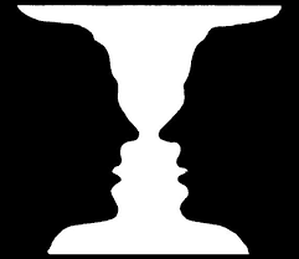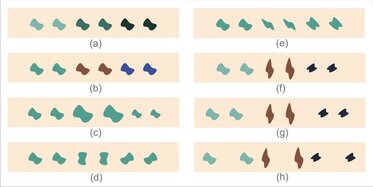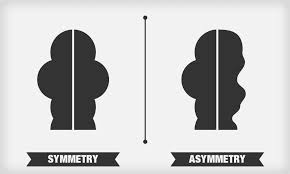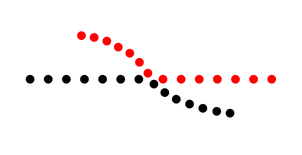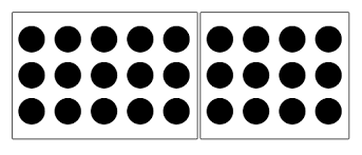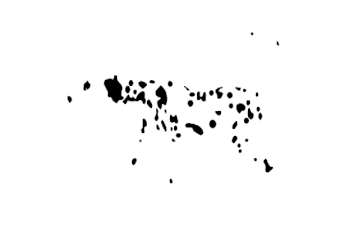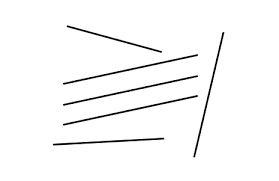~ The Gestaltists ~
|
What is the first image that you see in the picture on your left? Do you see a picture of two human profiles in black facing one another on a white background, or, do you see a picture of a white vase or goblet on a black background? Using the vernacular of the Gestaltists, which do you see first, the figure, or the ground? this is known as the principle or law of pragnanz (see below). The Gestalt movement represents the way in which we learn about the world based upon how our brain accommodates to the images we see and how as unique individuals, we make sense of that information. This is the science of perceptual organization. |
The English translation of the German word Gestalt is shape, and was first used in its current form in the late 1880s when the late great German physiologist Hermann Helmholtz was finally recognized en masse for his earlier groundbreaking work on his multiple discoveries in the field of sensation and perception. It was these vital discoveries on
sensation and perception by Helmholtz that paved the way for the Gestalt movement and the behavioral movement which followed after.
In 1890, Austrian philosopher and a member of the influential School of Brentano helmed by Franz Brentano, Christian von Ehrenfels, discovered and coined the concept of Gestalt and with it created an important paradigm shift that is with us today. As is typical of nearly all discoveries they are by and large a product, in whole or in part of the influential thinkers, movers and/or shakers of the day. Such was the case with von Ehrenfels who was influenced by the Phenomenologists at the end of the 19th century and beginning of the 20th century. The Phenomenologists and kindred spirits of the School of Brentano, included Edmund Husserl, known as the father of the phenomenological movement, despite the fact that the phenomenologists before him and also members of the School of Brentano, such as famed psychoanalyst Sigmund Freud, were already followers of the phenomenological, an introspective tradition that was in stark contrast to the physiological movement.
Just a few years after von Ehrenfels brought to light the concept of Gestalt, and on little more then a curious whim in 1910, a young Max Wertheimer ditched his summer vacation from the German University of Frankfurt, enlisted two of his buddies, Kurt Koffka, and Wolfgang Kohler, and conducted their own little research experiment in which a mere two years later, started an entire world-wide paradigm that today is known as Gestalt psychology (many people assume that Fritz Perls was the founder of Gestalt psychology but that is false. Perls was the founder of Gestalt *therapy*, based upon the principles of Gestalt psychology founded by Wertheimer, Koffka, and Kohler).
Prior to Helmholtz's work in the mid 1800s, the working theory of physiology was a doctrine called vitalism and was held by his mentor, Muller at the Muller Institute where Helmholtz studied. Vitalism suggested that all living creatures were possessed of a vital life force that could not be subjected to scientific inquiry. Helmholtz disagreed. Borrowing from Newton, Helmholtz believed (and brilliantly demonstrated) like Newton before him, that physiological mechanisms were based on the principles of biochemistry and easily studied and understood by standard experimentation. The theory of vitalism was immediately replaced by mechanism. In what today seems like such an obvious assertion, it was Helmholtz that discovered and affirmed that not only were sensation and perception different things, but that sensation was brought about by the firing of nerve fibers which is completely physiological, while perception, a completely different process, was something that acquired, and therefore under the subjective experience of the individual.
We know that sensation is the ability to receive information about the world from one of our five senses; taste, touch, smell, sight, and hearing. But it is our perception of those sensations that interprets the information and can distinguish a pickle from a pear, or Handel from hip-hop. The works of Helmholtz are too numerous to mention here, but suffice it to say his attention and hence experimentation was focused on visual perception and the measurement of the speed with which a nerve impulse travels along a nerve fiber (Fancher, 1996). This gave rise to among other things, the discovery of color vision emanating from three different kinds of primary visual receptor cells, from which all color is perceived. This became known as the famous Young-Helmholtz trichromatic theory of color, giving credit to the researcher Thomas Young, who in 1802 separately worked on color vision and wrote of three different photoreceptors responsible for color-mixing.
These were the very early days when modern psychology depended on the knowledge and successful psychophysiological experimentation on the brain, which interestingly, not much prior to 1900, was considered part and parcel of the soul.
There are certain laws or principles upon which the Gestaltists ground their theory, presented here in no particular order...
sensation and perception by Helmholtz that paved the way for the Gestalt movement and the behavioral movement which followed after.
In 1890, Austrian philosopher and a member of the influential School of Brentano helmed by Franz Brentano, Christian von Ehrenfels, discovered and coined the concept of Gestalt and with it created an important paradigm shift that is with us today. As is typical of nearly all discoveries they are by and large a product, in whole or in part of the influential thinkers, movers and/or shakers of the day. Such was the case with von Ehrenfels who was influenced by the Phenomenologists at the end of the 19th century and beginning of the 20th century. The Phenomenologists and kindred spirits of the School of Brentano, included Edmund Husserl, known as the father of the phenomenological movement, despite the fact that the phenomenologists before him and also members of the School of Brentano, such as famed psychoanalyst Sigmund Freud, were already followers of the phenomenological, an introspective tradition that was in stark contrast to the physiological movement.
Just a few years after von Ehrenfels brought to light the concept of Gestalt, and on little more then a curious whim in 1910, a young Max Wertheimer ditched his summer vacation from the German University of Frankfurt, enlisted two of his buddies, Kurt Koffka, and Wolfgang Kohler, and conducted their own little research experiment in which a mere two years later, started an entire world-wide paradigm that today is known as Gestalt psychology (many people assume that Fritz Perls was the founder of Gestalt psychology but that is false. Perls was the founder of Gestalt *therapy*, based upon the principles of Gestalt psychology founded by Wertheimer, Koffka, and Kohler).
Prior to Helmholtz's work in the mid 1800s, the working theory of physiology was a doctrine called vitalism and was held by his mentor, Muller at the Muller Institute where Helmholtz studied. Vitalism suggested that all living creatures were possessed of a vital life force that could not be subjected to scientific inquiry. Helmholtz disagreed. Borrowing from Newton, Helmholtz believed (and brilliantly demonstrated) like Newton before him, that physiological mechanisms were based on the principles of biochemistry and easily studied and understood by standard experimentation. The theory of vitalism was immediately replaced by mechanism. In what today seems like such an obvious assertion, it was Helmholtz that discovered and affirmed that not only were sensation and perception different things, but that sensation was brought about by the firing of nerve fibers which is completely physiological, while perception, a completely different process, was something that acquired, and therefore under the subjective experience of the individual.
We know that sensation is the ability to receive information about the world from one of our five senses; taste, touch, smell, sight, and hearing. But it is our perception of those sensations that interprets the information and can distinguish a pickle from a pear, or Handel from hip-hop. The works of Helmholtz are too numerous to mention here, but suffice it to say his attention and hence experimentation was focused on visual perception and the measurement of the speed with which a nerve impulse travels along a nerve fiber (Fancher, 1996). This gave rise to among other things, the discovery of color vision emanating from three different kinds of primary visual receptor cells, from which all color is perceived. This became known as the famous Young-Helmholtz trichromatic theory of color, giving credit to the researcher Thomas Young, who in 1802 separately worked on color vision and wrote of three different photoreceptors responsible for color-mixing.
These were the very early days when modern psychology depended on the knowledge and successful psychophysiological experimentation on the brain, which interestingly, not much prior to 1900, was considered part and parcel of the soul.
There are certain laws or principles upon which the Gestaltists ground their theory, presented here in no particular order...
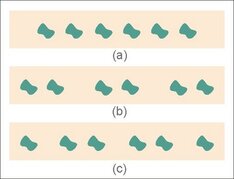
Law of Proximity: This principle states that objects close together, that are proximate to one another, the brain associates those objects with one another, then objects are not close to together. i.e., the brain interprets the middle row (b) as those objects as not belonging together, unlike those objects in the other columns, with the first column as easily being seen as one, as they are all in equal and close proximity to one another.
|
Law of Figure-Ground: This principle, exactly the same principle as the one shown at the top of this page, shows (and this happens to be my favorite example) two possible pictures; a white apple that has been bitten into, on a black background, and the silhouette of the late Steve Jobs of Apple, in black, with a white background in the center. Which do you see first, and are you able to switch and see each of them either separately or together? This principle demonstrates how the brain is able to focus and then switch visual perception.
|
|
Law of Continuity: It might take you more then one try to see that our brain first focuses on the curved line and sees the entirety of the curve as one object. But if you pay attention, the red dots do not form a curved line, the curved line is actually composed of two separate, bent lines. But not to our brain, which prefers and will automatically see the curved line as one, and the straight line as one, and will not see the two bent lines until closer or more effortful attention. |
|
Law of Common Fate: In this fascinating example of perceptual organization, there are nothing more than a bunch of black dots of unequal size, thickness, and shape that is set to motion. The fact that the black dots are all in one smooth motion going in one direction, enables the brain to process this group of dots as a running Dalmatian. |
|
Law of Synchrony: This principle shows us that separate objects, in this case a picture of two different swimmers that are diving in complete unity, or synchronously, enables the brain to automatically perceive this as a single image. In other words, the two separate women are perceived as being of one group. In the Olympic sport of synchronized diving, the highest points are awarded to those two divers that are in such perfect alignment, that they are nearly indistinguishable from one another. Those that remember the famous Rockettes of Radio City Music Hall in New York City, used to marvel at the famous synchronicity that the gals would dance and lift their legs at such precise angles, as to appear all in one completely straight line. |

